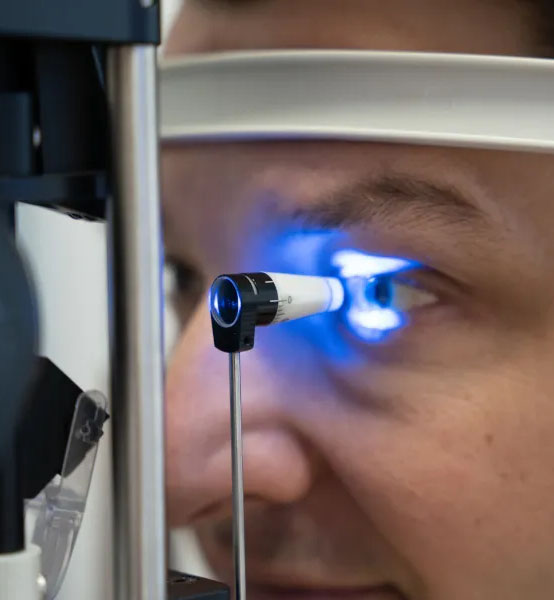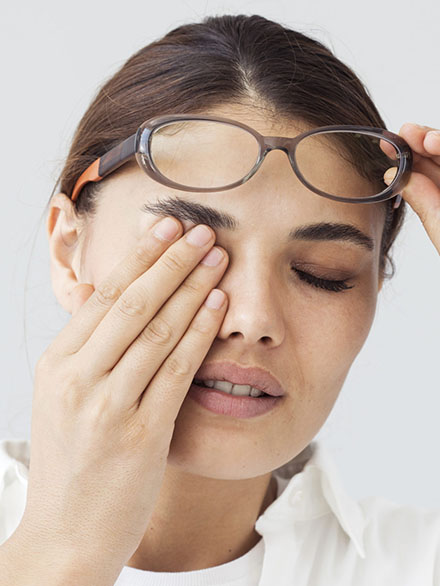Best Glaucoma Treatment at Agarwal Eye Hospital
Glaucoma is a group of eye conditions that damage the optic nerve. The optic nerve sends visual information from your eye to your brain and is vital for good vision. Damage to the optic nerve is often related to high pressure in your eye. But glaucoma can happen even with normal eye pressure.
Glaucoma can occur at any age but is more common in older adults. It is one of the leading causes of blindness for people over the age of 60.
Many forms of glaucoma have no warning signs. The effect is so gradual that you may not notice a change in vision until the condition is in its later stages.
It’s important to have regular eye exams that include measurements of your eye pressure. If glaucoma is recognized early, vision loss can be slowed or prevented.

Glaucoma

Glaucoma refers to an eye disease that indirectly damages the optic nerve due to the high pressure inside the eye. This is the nerve that transport eye information from your eyes to your brain. As glaucoma attacks your optic nerve, the areas of vision such as peripheral (side) vision become the first to begin to disappear. Thereafter, deterioration of the central (straight ahead) vision could be caused by glaucoma as well. You could not notice loss of side vision until lost a good proportion yet of your sight. The ophthalmoscope used by the doctor to check for glaucoma looks for harm to the optic nerve and a possible decline in the peripheral vision. They may be able to test your eye pressures as well.
Glaucoma is called ‘sneak thief’ because people are not aware of the onset of the symptoms until they already had damage in the vision. Vision is one of the five senses. Once lost, it does not grow back.
Symptoms
In some types of glaucoma, there aren’t any early warning symptoms, and changes to vision can happen gradually, so the symptoms are easy to miss. Because people with open-angle glaucoma don’t have any noticeable symptoms, it’s very important to have routine eye exams to detect this disease in its earlier stages. Glaucoma damage is irreversible, so you need early detection and treatment to prevent blindness.
Closed-angle glaucoma has more severe symptoms that tend to come on suddenly.
With any type, you may experience:
- Eye pain or pressure.
- Headaches.
- Rainbow-colored halos around lights.
- Low vision, blurred vision, narrowed vision (tunnel vision) or blind spots.
- Nausea and vomiting.
- Red eyes.


Types of Glaucoma
There are several types of glaucoma, including:
Open-angle glaucoma
This type is the most common, affecting up to 90% people who have glaucoma. It occurs when resistance builds up in your eye’s drainage canals. Your drainage canals appear to be open and functioning normally. Over months or years, the fluid in your eye can build up and put pressure on your optic nerve. The disease may go unnoticed for years because most people don’t have symptoms.
Closed-angle glaucoma
Also called angle-closure or narrow-angle glaucoma, this rare type often comes on suddenly (acute). It occurs when the angle between your iris and cornea is too narrow. It may happen when your pupil changes and becomes too big (dilated) too quickly. This blocks your drainage canals and prevents aqueous fluid from leaving your eye, causing eye pressure to rise. Symptoms, including eye pain and headaches, can be severe and require immediate medical attention.
Normal-tension glaucoma
As many as 1 in 3 people have optic nerve damage even when eye pressure is normal or not very high. Experts are uncertain about what causes normal-tension glaucoma. Another name for this type is normal-pressure or low-tension glaucoma. This type is more common among people of Asian descent or Asian Americans.
Congenital glaucoma
Some babies are born with drainage canals that don’t form properly in the womb. Your healthcare provider might notice your baby’s glaucoma symptoms at birth or signs may become noticeable during childhood. Other names for this type are childhood, infantile or pediatric glaucoma.
Management and Treatment
Diagnosis
It’s possible to have glaucoma and not know it. Regular eye exams are important to catch glaucoma or other eye problems. Eye exams can assess optic health and vision loss.
To check for glaucoma, an eye doctor may do one or more of these painless tests: Dilated eye exam. Gonioscopy. Optical coherence tomography (OCT). Ocular pressure test (tonometry). Pachymetry. Slit-lamp exam. Visual acuity test (eye charts). Visual field test (perimetry).
Medications to treat glaucoma
Many types of prescription eye drops can treat glaucoma. Some decrease fluids and increase drainage to improve eye pressure. Because glaucoma is a lifelong condition, you may need to use daily eye drops for life. You may have to apply them more than once a day.
Laser therapy to treat glaucoma
Your eye doctor uses a laser (a strong beam of light) to help improve fluid drainage from your eye. Your provider may suggest lasers as a first-line therapy instead of drops or in addition to eye drops. Having laser treatment may not replace the use of eye drops completely. The results from laser treatments vary but can last for years in some cases. Your provider may be able to repeat some types of laser treatments.
Surgery to treat glaucoma
Surgery is another way to help reduce eye pressure. It’s more invasive but can also achieve better eye pressure control faster than drops or lasers. Surgery can help slow down vision loss, but it can’t restore lost vision or cure glaucoma. There are many types of surgeries for glaucoma, and depending on the specific type and severity, your eye doctor may choose one over another.
Prevention
If the IOP (Intraocular pressure) can be brought back to normal through controlling it, the vision may never get worse or will be slowed severely. Nonetheless, without a permanent cure of the glaucoma people might need those or similar medications for the rest of their life to use them for IOP regulation. However, visual capacity that is degraded to the point of blindness after glaucoma is permanently lost. Glaucoma cannot be completely avoided, but it is still relevant to capture it in the earlier stage in order that the treatments can be started to prevent it from getting worse. To prevent anglet type of glaucoma, you need to be doing yearly screening of the eyes.


Usefull Links
Information
Monday to Saturday
Morning: 11:00 am to 2:00 pm
Evening 7:00 pm- 9:00 pm
Sunday Closed

